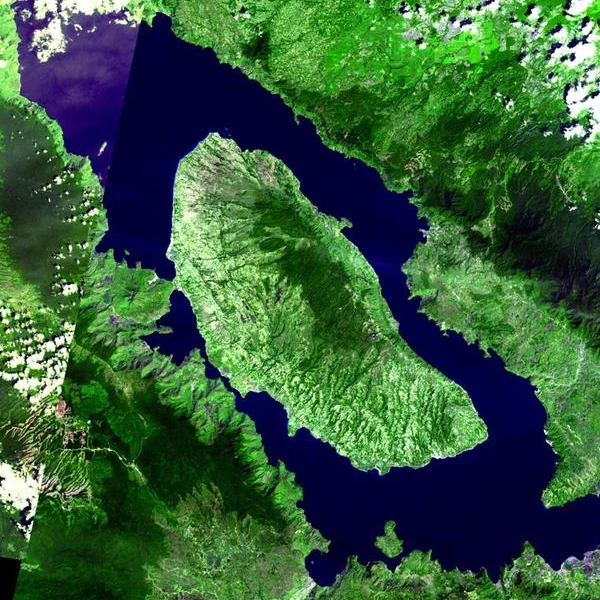
Supervolcanoes are exceptional geological formations capable of releasing more than 1,000 km³ of magma in a single eruption, several thousand times the energy of a classic volcano. Unlike visible conical volcanoes, these giants are often hidden beneath vast calderas, the result of successive collapses of the Earth's crust. Their operation is governed by the slow but colossal accumulation of magmatic pressure.
The eruption of a supervolcano is a planetary-scale event. During a VEI 8 eruption, hundreds of millions of tons of volcanic ash, sulfur gases, and aerosols are propelled into the stratosphere, blocking part of the solar radiation. This causes abrupt climate cooling, sometimes by several degrees Celsius across the entire planet, lasting for several years.
This sudden decrease in sunlight disrupts photosynthesis, shortens growing seasons, and causes droughts or excessive precipitation depending on the region. The direct consequence is a global reduction in agricultural yields. Climate models coupled with agro-economic simulations predict that even a 10 to 15% decrease in global wheat or corn production could be enough to trigger food shortages in many countries.
Our modern civilization relies on energy infrastructures, transport networks, global food markets, and interconnected digital systems. A major eruption could severely disrupt these systems: paralysis of air traffic, collapse of logistics chains, power outages, loss of satellite data, financial disorganization. These systemic effects could lead to large-scale social and political destabilizations.
History has already experienced episodes close to such scenarios. The eruption of Tambora in 1815 (VEI 7 index) caused the "year without a summer" in 1816, leading to famines, migrations, and civil unrest. Yet, Tambora was not a supervolcano. If a Yellowstone-type volcano were to erupt today, its impacts would be comparable to those of a nuclear war or a collision with an asteroid several kilometers wide.
The estimated probability of a supereruption in the coming century remains extremely low (on the order of 1 in 700, or about 0.14% according to some statistical studies). If such an eruption were to occur, its effects could be severe on a regional scale and have global climatic repercussions, but significant uncertainties remain about the exact extent of the consequences on modern societies.
Supervolcanoes should therefore not be seen as imminent threats, but rather as rare events with high potential impact, to be considered in long-term resilience models. A better understanding of magmatic pressurization mechanisms, improvement of early detection systems, and international protocols for geological risk management are reasonable ways to anticipate without catastrophism.
A supervolcanic eruption is not only measured in volumes of lava but also in thermal energy, the amount of ash released (up to several trillion tons), and sulfur injected into the stratosphere. This can induce a lasting "volcanic winter," reduce global photosynthesis, and cause a global temperature drop of several degrees.
| Name | Location | Date of last supereruption | Ejected volume (km³) | VEI Index |
|---|---|---|---|---|
| Yellowstone | United States (Wyoming) | 640,000 years | ≈ 1,000 | 8 |
| Toba | Indonesia (Sumatra) | 74,000 years | ≈ 2,800 | 8 |
| Taupō | New Zealand | 26,500 years | ≈ 1,170 | 8 |
| Campi Flegrei | Italy (Naples) | 39,000 years | ≈ 300 | 7 |
| La Garita | United States (Colorado) | 27.8 million years | ≈ 5,000 | 8+ |
| Long Valley | United States (California) | 760,000 years | ≈ 600 | 7 |
| Valles Caldera | United States (New Mexico) | 1.25 million years | ≈ 300 | 7 |
| Atana | Chile (Altiplano-Puna) | 4 million years | ≈ 2,500 | 8 |
| Aira Caldera | Japan (Kyushu) | 22,000 years | ≈ 200 | 7 |
Supervolcanoes result from natural geological processes on the scale of hundreds of thousands of years, involving gigantic magma chambers buried under several kilometers of the Earth's crust. Currently, no human technology allows direct intervention on these magma reservoirs to prevent or control an eruption. Their volume, depth, and the physicochemical complexity of the magmas make any attempt at direct mitigation technically unrealistic.
The best strategy to limit the risks associated with supervolcanoes relies on rigorous and multidisciplinary geophysical monitoring: measuring ground deformations (GPS, InSAR), tracking seismicity, analyzing gas emissions (CO2, SO2), and geothermal imaging. These data allow the detection of precursor signs such as magma ascent or pressure buildup. However, precursor signals may appear several decades before an eruption, leaving limited time for planning and evacuation.
Beyond scientific monitoring, prevention involves preparing exposed populations: evacuation plans, food resource management, critical infrastructure reinforcement, and transparent communication. International cooperation is also essential to coordinate responses to a global-scale catastrophe. Civil and ecological resilience remains a key element, as even good anticipation cannot completely eliminate the impacts of a supereruption.
It is currently not possible to prevent a supervolcano-related catastrophe through direct intervention. Prevention relies mainly on early detection, risk management, and societal preparation.
Institutions such as the USGS ensure continuous monitoring of geological areas that may harbor supervolcanoes. However, the complete understanding of the internal dynamics of these structures remains limited. The pressurization phase of the magma reservoir can extend over several centuries, often interspersed with long periods of low or almost no activity. These supervolcanoes, although imposing, are generally considered dormant rather than active systems, and their evolution remains difficult to predict with precision. Their eruptive potential underscores the importance of continuous scientific monitoring, but without assuming an imminent risk likely to directly threaten modern civilization.
Sources: Smithsonian Institution – Global Volcanism Program, USGS – Yellowstone Observatory, Nature Geoscience, 2020